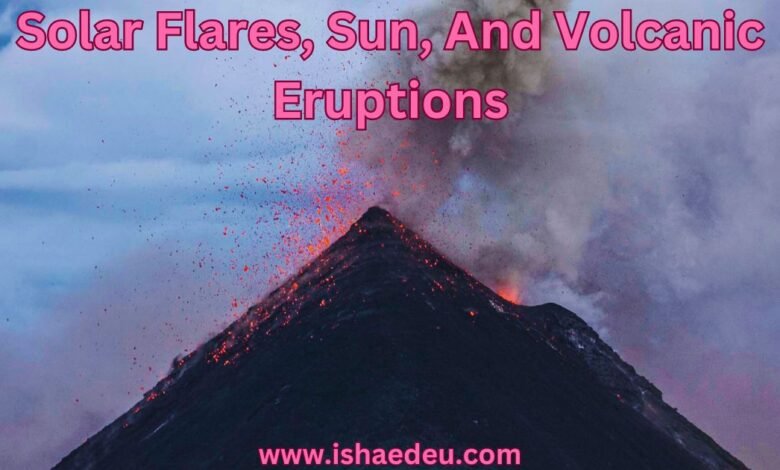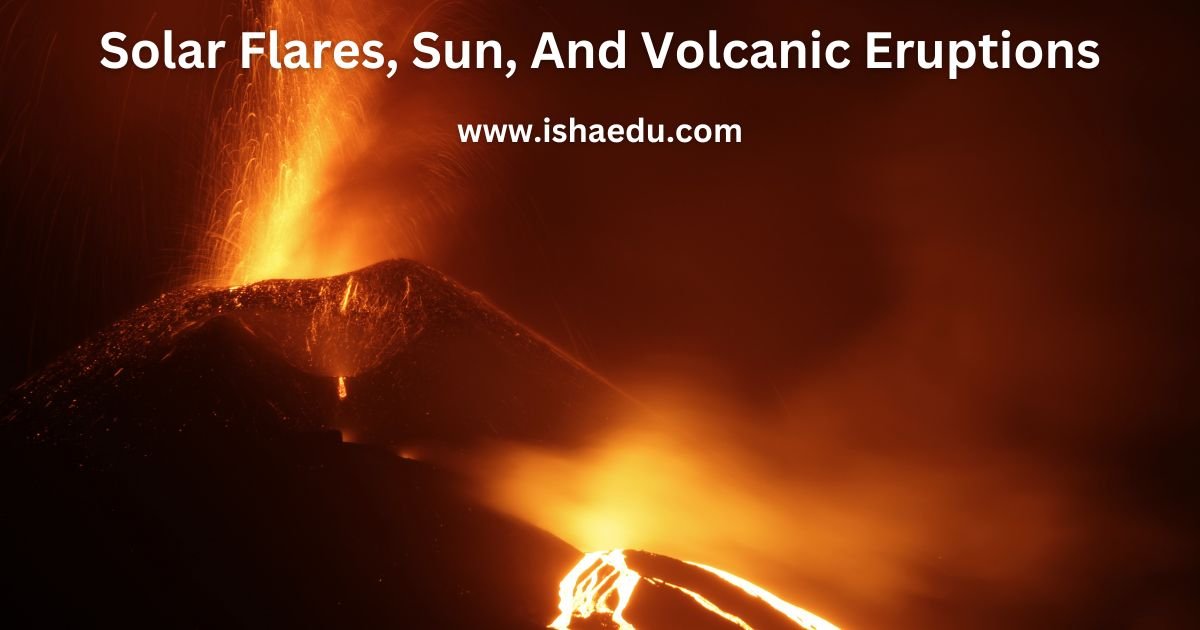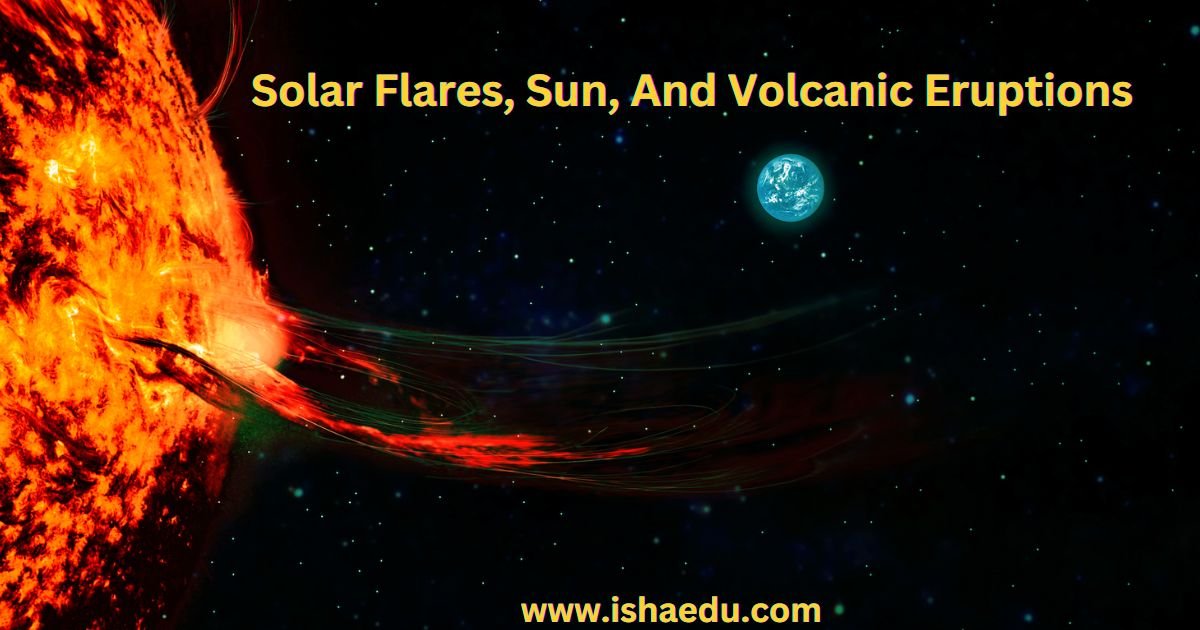Solar Flares, Sun, And Volcanic Eruptions

Solar Flares, Sun, And Volcanic Eruptions
While both solar flares and volcanic eruptions unleash formidable energy, their origins and characteristics diverge significantly. Grasping these disparities is pivotal for accurately gauging their potential ramifications.
Solar Flares:
- Origin: Solar flares surge from the Sun’s surface, spurred by the abrupt release of magnetic energy within its atmosphere.
- Energy: They emit powerful bursts of electromagnetic radiation across diverse spectra, including X-rays, ultraviolet rays, and radio waves.
- Impact on Earth: Depending on their intensity and trajectory, solar flares can disrupt radio communications, impair satellites, and even induce power grid failures. Nonetheless, Earth’s magnetic shield affords substantial protection against their adverse effects.
Volcanic Eruptions: Earth’s Molten Wrath
- Origin: Volcanic eruptions transpire when molten rock, ash, and gases spew forth from Earth’s crust, propelled by the shifting of tectonic plates and the accumulation of pressure within the mantle.
- Energy: The energy released during volcanic eruptions can be staggering, encompassing thermal energy, kinetic force, and the potential for seismic waves.
- Impact on Earth: Volcanic eruptions wield the capacity for widespread devastation in their immediate vicinity, with streams of lava, ash plumes, and pyroclastic flows posing formidable hazards. Furthermore, they can inject aerosols into the atmosphere, influencing regional and global climatic patterns.
Conclusion:
Although solar flares and volcanic eruptions exhibit formidable force as natural occurrences, they stem from divergent origins, possess unique traits, and yield distinct repercussions. Acknowledging these disparities is imperative for preemptively addressing and alleviating their possible aftermaths, safeguarding our planet’s and its inhabitants’ welfare and security.

What is the definition of a volcanic eruption?
A volcanic eruption is when molten rock, ash, and gas are released from Earth’s crust. This material, called magma or lava when it reaches the surface, comes from deep within the Earth. It can erupt gently as lava flows or explosively with ash and gas, depending on the type of volcano and the magma’s properties.
Can solar flares cause volcanic eruptions?
Solar flares can’t directly trigger volcanic eruptions. They’re different phenomena with separate origins and mechanisms. While some research suggests a possible indirect link, it’s complex and debated, and most scientists agree it’s unlikely.
Does the Sun affect volcanoes?
The Sun’s effect on volcanoes is still being studied, but it’s likely small compared to other factors. While some studies suggest a link to solar activity, it’s not conclusive. Volcanic eruptions can cool Earth by reflecting sunlight, but this is temporary.
What is a solar flare on the Sun?
A solar flare is a giant burst of energy from the Sun, like a powerful explosion. It releases light and particles across almost the entire electromagnetic spectrum and can vary in size and intensity. While some flares are barely noticeable, others can impact Earth and technology, like causing auroras or radio blackouts. Scientists monitor the Sun to understand and prepare for these events.
What is the effect of the volcanic eruption on solar radiation?
Volcanic eruptions can affect solar radiation in a few ways, mainly by:
- Blocking: Ash and dust can reflect sunlight into space, causing temporary cooling.
- Absorbing: Gases like sulfur dioxide can form aerosols that absorb some solar radiation, also contributing to cooling.
The size, explosiveness, and height of the eruption all influence the impact. These effects are usually temporary, but they can be significant.
What are the three primary factors that lead to volcanic eruptions?
Volcanoes erupt due to:
- Moving tectonic plates: Colliding plates melt rock, creating magma that rises and erupts.
- Hot mantle plumes: These plumes melt rock, forming magma that erupts as volcanoes.
- Pressure changes: Decreasing pressure allows gas in magma to expand, causing an eruption.
What causes volcanic eruptions?
Volcanoes erupt due to a mix of factors deep within Earth, mainly involving heat, pressure, and gas. Hot, buoyant magma rises, and pressure or gas buildup can trigger an eruption. The specifics vary depending on the volcano.
What are the 4 factors that cause volcanic eruptions?
Four main ingredients stir the pot for volcanic eruptions:
- Moving continents: Colliding continents melt rock, creating magma that can rise and erupt.
- Hot underground plumes: These plumes melt rock, forming magma that erupts as volcanoes.
- Magma’s makeup: Runny magma lets gas out easily, leading to gentle lava flows. Thick magma traps gas, causing explosive eruptions.
- Volcano’s shape: A volcano’s structure can affect how an eruption unfolds.
These factors often work together to trigger an eruption.
What are the types of volcanic eruptions?
Volcanic eruptions happen when hot, molten rock (magma) rises and escapes Earth’s surface. Two main types exist:
- Effusive eruptions: Gentle lava flows with little ash.
- Explosive eruptions: Violent releases of ash, cinders, and gas.
The type depends on the magma’s composition, gas content, and the volcano’s structure.

سورج کے شعلے، سورج اور آتش فشاں پھٹنا
جبکہ سورج کے شعلے اور آتش فشاں پھٹنے سے بڑی مقدار میں توانائی خارج ہوتی ہے، ان کے آغاز اور خصوصیات کافی حد تک مختلف ہیں۔ ان اختلافات کو سمجھنا ان کے ممکنہ اثرات کا صحیح اندازہ لگانے کے لیے ضروری ہے۔
سورج کے شعلے:
ماخذ: سورج کے شعلے اس کے سطح سے نکلتے ہیں، جو اس کے ماحول میں مقناطیسی توانائی کی اچانک رہائی سے تیار ہوتے ہیں۔
توانائی: وہ مختلف سپیکٹرا پر برقی مقناطیسی تابکاری کے طاقتور پھٹ پڑتے ہیں، جن میں ایکس رے، الٹرالیٹ شعاعیں اور ریڈیو لہریں شامل ہیں۔
زمین پر اثر: ان کی شدت اور سمت کے لحاظ سے، سوریج کے شعلے ریڈیو مواصلات کو سکت پہنچا سکتے ہیں، سیٹلائٹوں کو نقصان پہنچا سکتے ہیں، اور یہاں تک کہ بجلی کے گرڈ کی ناکامی کا باعث بن سکتے ہیں۔ تاہم، زمین کی مقناطیسی ڈھال ان کے منفی اثرات سے کافی تحفظ فراہم کرتی ہے۔
آتش فشاں پھٹنا: زمین کا پگھلا غصہ
ماخذ: آتش فشاں پھٹنا اس وقت ہوتا ہے جب پگھلی چٹان، راکھ اور گیسین زمین کی پرت سے باہر پھٹتی ہیں، جو ٹیکٹونک پلیٹوں کی نقل و حرکت اور گوشہ میں دباؤ کے جمع ہونے کی وجہ سے ہوتی ہے۔
توانائی: آتش فشاں پھٹنے کے دوران خارج ہونے والی توانائی حیرت انگیز ہو سکتی ہے، جس میں تھرمل توانائی، حرکی قوت اور زلزلوں کی لہروں کی صلاحیت شامل ہے۔
زمین پر اثر: آتش فشاں پھٹنے سے ان کے قریبی علاقوں میں بڑے پیمانے پر تباہی پھیلنے کی صلاحیت ہوتی ہے، لاوا کے بہاؤ، راکھ کے بادل اور آتش فشاں بہاؤ سنگین خطرات لاحق کرتے ہیں۔ اس کے علاوہ، وہ ماحول میں ایروسلز داخل کر سکتے ہیں، جو علاقائی اور عالمی موسمیاتی نمونوں کو متاثر کرتے ہیں۔
نتیجہ:
اگرچہ سوریج کے شعلے اور آتش فشاں پھٹنا قدرتی واقعات کے طور پر زبردست قوت کا مظاہرہ کرتے ہیں، وہ مختلف اصل سے پیدا ہوتے ہیں، منفرد خصوصیات رکھتے ہیں اور الگ الگ نتائج برآمد کرتے ہیں۔ ان اختلافات کو تسلیم کرنا ان کے ممکنہ نتائج سے پہلے سے نمٹنے اور انہیں کم کرنے کے لیے ضروری ہے، تاکہ ہمارے سیارے اور اس کے باشندوں کی فلاح و بہبود اور تحفظ کو یقینی بنایا جا سکے۔
اکثر پوچھے گئے سوالات
آتش فشاں پھٹنے کی تعریف کیا ہے؟
آتش فشاں پھٹنا اس وقت ہوتا ہے جب پگھلی چٹان، راکھ اور گیسین زمین کی پرت سے باہر نکلتی ہیں۔ یہ مواد، جسے ماگما یا لاوا کہا جاتا ہے جب یہ سطح پر پہنچتا ہے، زمین کے اندر سے گہرائی سے آتا ہے۔ یہ آتش فشاں کی قسم اور ماگما کی خصوصیات کے لحاظ سے آہستہ لاوا کے بہاؤ یا راکھ اور گیس کے ساتھ زور دار پھٹ سکتا ہے۔
کیا سولر فلیر آتش فشاں پھٹنے کا سبب بن سکتے ہیں؟
سولر فلیرز براہ راست آتش فشاں پھٹنے کو متحرک نہیں کر سکتے۔ وہ الگ الگ اصل اور طریقہ کار کے ساتھ مختلف مظاہر ہیں۔ جبکہ کچھ تحقیق ایک ممکنہ غیر مستقیم رابطے کی تجویز دیتی ہے، یہ پیچیدہ اور بحث ہے، اور زیادہ تر سائنسدان اس بات سے اتفاق کرتے ہیں کہ یہ غیر متوقع ہے۔
کیا سورج آتش فشاں کو متاثر کرتا ہے؟
آتش فشاں پر سورج کے اثرات پر اب بھی تحقیق کی جا رہی ہے، لیکن یہ امکان ہے کہ یہ دوسرے عوامل کے مقابلے میں کم ہے۔ جبکہ کچھ مطالعات شمسی سرگرمی سے تعلق کی تجویز دیتے ہیں، یہ حتمی نہیں ہے۔ آتش فشاں پھٹنے سورج کی روشنی کو منعکس کر کے زمین کو ٹھंडا کر سکتے ہیں، لیکن یہ عارضی ہے۔
سورج پر سولر فلیر کیا ہے؟
سولر فلیر سورج سے توانائی کا ایک بہت بڑا پھٹ ہے، جیسے ایک طاقتور دھماکہ۔ یہ تقریباً پورے برقی مقناطیسی سپیکٹرم میں روشنی اور ذرات خارج کرتا ہے اور سائز اور شدت میں مختلف ہو سکتا ہے۔ جبکہ کچھ فلیرز مشکل سے محسوس ہوتے ہیں، دوسرے زمین اور ٹیکنالوجی کو متاثر کر سکتے ہیں، جیسے اورورا یا ریڈیو بلیک آؤٹ کا باعث بنتے ہیں۔ سائنسدان ان واقعات کو سمجھنے اور ان کی تیاری کے لیے سورج کی نگرانی کرتے ہیں۔
آتش فشاں پھٹنے کا شمسی تابکاری پر کیا اثر پڑتا ہے؟
آتش فشاں پھٹنے کئی طریقوں سے شمسی تابکاری کو متاثر کر سکتے ہیں، بنیادی طور پر:
روکنے: راکھ اور گرد زمین کی طرف سے آنے والی روشنی کو منعکس کر کے خلا میں واپس بھیج سکتی ہے، جس سے عارضی ٹھنڈک پڑتی ہے۔
جذب کرنا: گندھک ڈائی آکسائیڈ جیسی گیسین ایروسلز بنا سکتی ہیں جو کچھ شمسی تابکاری کو جذب کرتی ہیں، جس سے ٹھنڈک میں بھی مدد ملتی ہے۔
پھٹنے کا سائز، شدت اور بلندی سب ہی اثر کو متاثر کرتے ہیں۔ یہ اثرات عام طور پر عارضی ہوتے ہیں، لیکن وہ کافی اہم ہو سکتے ہیں۔
آتش فشاں پھٹنے کی 3 اہم وجوہات کیا ہیں؟
آتش فشاں پھٹنے کی وجہ سے ہوتے ہیں:
حرکت پذیر ٹیکٹونک پلیٹیں: ٹکراتی ہوئی پلیٹیں چٹانوں کو پگھلا دیتی ہیں، جس سے ماگما بنتا ہے جو اوپر اٹھتا ہے اور پھٹتا ہے۔
گرم گوشہ کے پلمز: یہ پلم چٹانوں کو پگھلا دیتے ہیں، ماگما بناتے ہیں جو آتش فشاں کے طور پر پھٹتا ہے۔
دباؤ میں تبدیلی: کم ہوتا دباؤ ماگما میں گیس کو پھیلنے دیتا ہے، جس سے پھٹ پڑتا ہے۔

Join Us :
Click Here To Get Technology And Entertainment Notification:




